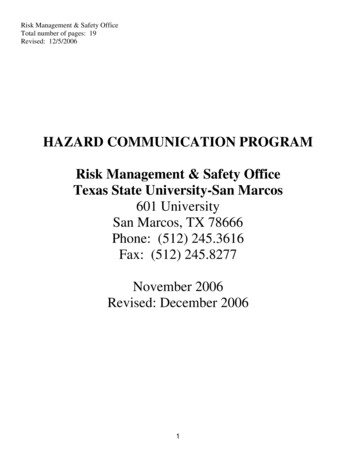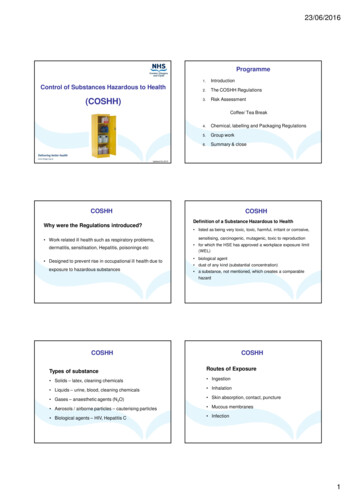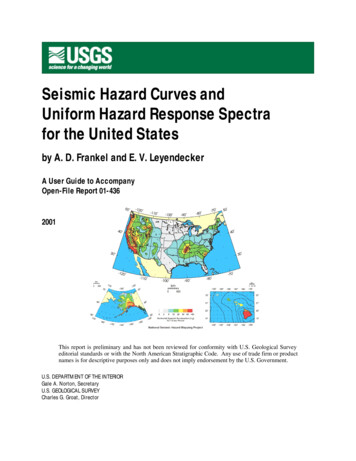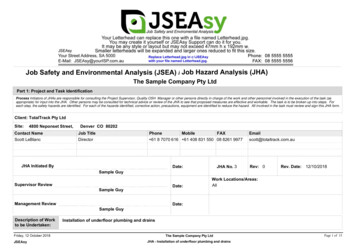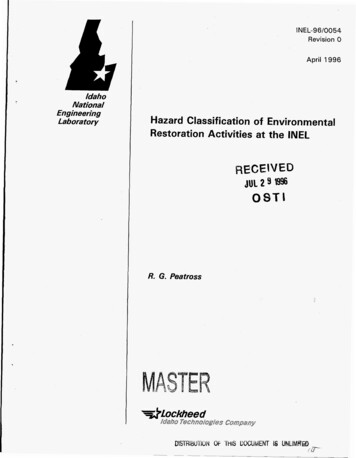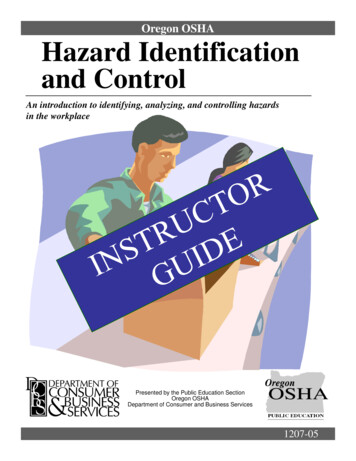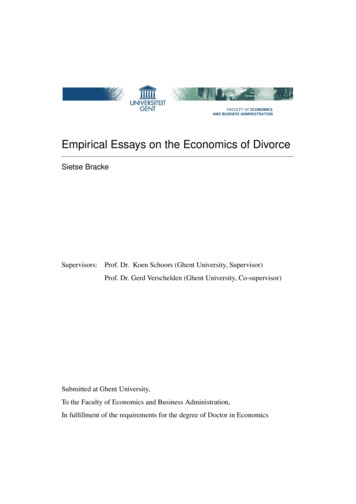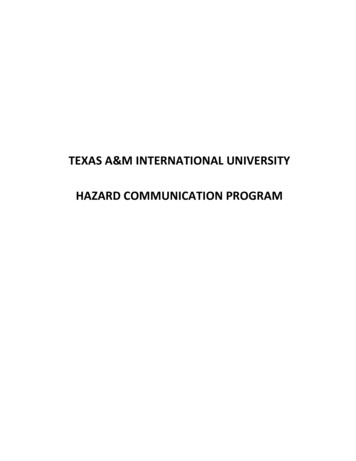
Transcription
TEXAS A&M INTERNATIONAL UNIVERSITYHAZARD COMMUNICATION PROGRAM
RECORD OF CHANGESChange #Subject Area ChangedChange Entered ByDate Entered1Minor names/department changesAdrian Dominguez11/23/092Adrian Dominguez11/23/09Adrian Dominguez11/23/094Updated Notice to Employees (Englishand Spanish)Addition of language pertaining to newonline training materialAddition of Appendix VAdrian Dominguez11/23/095Additional of WACI formKimberlee Sandoval12/11/096Addition of instructions for employeedeath or injuryUpdated page numbersKimberlee Sandoval12/11/09Adrian Dominguez01/06/1037801/06/109Addition of instructions for adding new- Kimberlee Sandovalhires into TrainTraqRecommended Changes ApprovedKimberlee Sandoval10UpdatedAdrian Dominguez6/30/201411UpdatedAdrian Dominguez and 6/30/2017Jessica Perez12Updated Right To Know FormAdrian Dominguez01/07/107/29/2019
Table of ContentsI.INTRODUCTION:II. EXEMPTIONS AND EXCEPTIONS – HSC 502.004; 506.005III.DUTIES AND RESPONSIBILITIES:IV.ACCIDENTAL RELEASEV.EMPLOYEE NOTICE AND RIGHTS OF THE EMPLOYEES - HSC 502.017:VI.EMPLOYEE TRAINING PROGRAM – HSC 502.009:VII.CHEMICAL INVENTORY – HSC 502.005 – 502.006:VIII.CHEMICAL CONTAINER LABELS - HSC 502.007:IX.SAFETY DATA SHEETS AND/OR MATERIAL SAFETY DATA SHEETS - HSC 502.006:X.REPORTING EMPLOYEE DEATHS AND INJURIES - HSC 502.012:XI.APPENDIX I DEFINITIONSXII.APPENDIX IIXIII.NOTICE TO EMPLOYEESXIV.APPENDIX IV WORK AREA CHEMICAL INVENTORY FORM INSTRUCTIONSXV.APPENDIX V
TEXAS A&M INTERNATIONAL UNIVERSITY HAZARD COMMUNICATIONPROGRAMI.INTRODUCTION:The Texas Hazard Communication Act (THCA), codified as Chapter 502 of the Health and Safety Code(HSC), requires public employers to provide information to employees regarding hazardous chemicalsthey may be exposed to in the workplace. In order to comply with Section 502.009(b) of the THCAand Section 295.7(a) of the THCA Rules (Titles 25 of the Texas Administrative Code (TAC), Section295.1 – 295.13), the following written Hazard Communication Program has been established for TexasA&M International University (TAMIU).The Public Employers Community Right-to-Know Act, Chapter 506 of the Health and Safety Code, andTexas Administrative Code (TAC), Title 25 Chapter 295, requires public employers to make informationregarding hazardous chemicals accessible to local fire departments and local emergency planningcommittees.Texas A&M International University (TAMIU), through the TAMIU Hazard Communication (HazCom)Program, will comply with this Act by providing training, appropriate personal protective equipment,and information regarding hazardous chemicals. The TAMIU HazCom Program is administeredthrough the Office of Environmental Health and Safety (EH&S) with responsibility for compliancedelegated throughout administrative channels to every supervisor. The HazCom Program applies toTAMIU employees, including student employees, who have occupational exposure to hazardouschemicals.II.EXEMPTIONS AND EXCEPTIONS – HSC 502.004; 506.005A. Per Section 502.004(f), the following chemicals are exempt from the requirements of the THCAand are outside the scope of this written program:1. Hazardous waste that is subject to regulation by the Texas Commission on EnvironmentalQuality (TCEQ) and/or the U.S. Environmental Protection Agency (EPA);2. A chemical in a laboratory under the direct supervision or guidance of a technicallyqualified individual if:a)labels on incoming containers of chemicals are not removed or defaced;b)compliance with Sections 502.006 and 502.009 of the THCSA with respect tolaboratory employees; andc)the laboratory is not used primarily to produce hazardous chemicals in bulk forcommercial purposes.3. Tobacco or tobacco products;4. Wood or wood products;5. Articles formed to a specific shape or design during manufacture and that do not releaseor otherwise result in exposure to a hazardous chemical under normal conditions of use;
6. Food, drugs, cosmetics, or alcoholic beverages;7. Consumer product or hazardous substance used in the workplace in the same manner asnormal consumer use and if the use results in a duration and frequency of exposure thatis not greater than exposures experienced by a consumer;8. Radioactive waste.B. Chemicals in a research laboratory are exempt from secondary labeling requirements andinventory requirements if:1. The lab is under the direct supervision of guidance of a technically qualified individual;2. Labels on primary containers of chemicals are not removed or defaced;3. Personnel training requirements are fulfilled;4. SDS access requirements are satisfied;5. The laboratory is not used primarily to produce hazardous chemicals in bulk forcommercial purposes.NOTE: Labels for small containers, such as test tubes or vials, may be attached to the rack orcontainer in which they are held, rather than on each tube or vial, if the contents of individualcontainers present the same hazard.III.DUTIES AND RESPONSIBILITIES:To facilitate administration of and compliance with this Program, the following levels of responsibilityhave been established:A. The TAMIU Office of Environmental Health and Safety (EH&S) will have overall responsibilityfor administering and maintaining the HazCom Program for TAMIU and ensuring that it meetsall the requirements of the THCA. Duties of the Office of Environmental Health and Safetyinclude:1. Assist departments with the implementation of and compliance with this Program;2. Serve as a contact for the Texas Commission on Environmental Quality (TCEQ) and/orTexas Department of State Health Services (DSHS);3. Post official “Notice to Employee” at locations where notices are normally posted;4. Submit required annual Texas Tier Two report to Texas A&M System Office forsubmission to TCEQ, by March 1 of the following year;5. Provide a copy of the annual Texas Tier Two report to the Local Emergency PlanningCommittee and to the local fire department(s);6. Provide the names and telephone numbers of emergency contacts to the local firedepartment(s), and provide WPCI lists and Safety Data Sheets (SDS) upon request;7. Report orally or in writing to DSHS, within 48 hours, the occurrence of a chemicalaccident that results in one or more fatalities or the hospitalization of five or moreemployees (this is to include circumstances of the accident, the number of fatalities, andthe extent of any injuries).8. Compile and maintain the Work Place Chemical Inventory (WPCI) lists;9. Maintain the WPCI lists for 30 years;
10. Assist departments with training programs, as appropriate;12. Assist departments in obtaining SDS.B. Directors, Department Heads, Supervisors, Lab Managers, and Administrators willadminister and coordinate the HazCom Program within their units. Their duties include:1. Ensure implementation of and compliance with this Program within the department;2. Notify EH&S, within 24 hours, the occurrence of a chemical accident. Notification is toinclude, circumstances of the accident, the number of fatalities, and the extent ofinjuries.3. Designate work areas as appropriate within each workplace.4. Conduct and ensure that all employees have received Work Area Specific Training.5. Allow on-site inspections upon request;6. Assist in the completion of the Work Area Chemical Inventory (WACI) for each work areaother than a research laboratory;7. Provide EH&S with WACI of the following year;8. Provide employees with appropriate personal protective equipment and ensure that theequipment fits the individual; ensure that all employees have received training beforeworking with or in an area containing chemicals;9. Assure that SDS on hazardous chemicals purchased are available, as required/10. Maintain and know how to access the WACI list, as appropriate;11. Inform employees how to access SDS.C. Employees are expected to successfully complete the online TrainTraq course # 11020 HazardCommunication. Employees are also expected to use prudent practices and good judgmentwhen using hazardous chemicals or hazardous procedures and to appropriately notify otherindividuals who might be affected by the chemicals they use.NOTE: Personnel who work with hazardous materials are expected to assume reasonableresponsibility for the safety and health of themselves, others around them, and theenvironment.D. Contracted Construction, Repair and Maintenance: Contractors must comply with Texas andFederal Hazard Communication Acts and the TAMIU HazCom Program regarding hazardous ornoxious chemicals or chemical products used during projects within Texas A&M InternationalUniversity facilities and property. Upon request, contractors will follow the following levels ofresponsibility :1. Office of Environmental Health and Safety may ask contractor(s) to provide priornotification of intended use of hazardous or noxious chemicals or chemical products tothe TAMIU Project Coordinator and/or EH&S.2. EH&S may ask contractor(s) to provide a list of hazardous or noxious chemicals orchemical products to be used on the project and shall provide appropriate hazardinformation, including SDSs, to the Project Coordinator.
IV.ACCIDENTAL RELEASEAccidental Releases - Party(s) responsible for the release of hazardous or noxious chemicals shallnotify TAMIU University Police by dialing extension 2911 from a campus phone or dialing (956) 3262911 from an outside line and notify all individuals in the affected area. The responsible party(s) shallalso provide to the Office of Environmental Health and Safety precautionary information, includingSDSs for the chemicals involved.V.EMPLOYEE NOTICE AND RIGHTS OF THE EMPLOYEES - HSC502.017:A. An official Texas Department of State Health Services "Notice to Employees" (see Appendix III)shall be posted and unobstructed at the location(s) where notices are normally posted. TheOffice of Environmental Health and Safety will post and maintain the most current version ofthe THCA Notice to Employees, informing employees of their rights under the Act.B. In workplaces where employees that have difficulty reading or understanding English may bepresent, a copy of the Notice to Employees, printed in Spanish, will be posted together withthe English version.C. EH&S shall ensure that TAMIU employees who may be exposed to hazardous chemicals beinformed of the exposure and be provided access to the pertinent workplace chemical listsand MSDSs for those hazardous chemicals.D. Texas A&M International University shall not discipline, harass, or discriminate against anyemployee for filing compliants, assisting inspectors of the Texas Department of State HealthServices, participating in proceeding related to the Texas Hazard Communication Act, orexercising rights under the Act.E. Employees cannot waive their rights under the Texas Hazard Communication Act. A requestor requirement for such a waiver by an employer is a violation of the Act.VI.EMPLOYEE TRAINING PROGRAM – HSC 502.009:Employee education and training are essential components of the TAMIU HazCom Program and areprovided through formal and informal instruction. Appropriate training shall be provided toemployees who use or handle hazardous chemicals as a part of their normal work assignments.Training of a new or newly assigned employee shall be given before the employee works with orhandles hazardous chemicals. Employees shall receive additional training when the potential forexposure to hazardous chemicals in the employee's work area increases significantly or whensupervisor receives new and significant information concerning the hazards of a chemical in theemployee's work area. The HazCom Program training includes two levels of training: (1) Generalsafety found online through TrainTraq course #11020 and (2) Work Area Specific Training conductedby the supervisor. Training on the topics of both levels must be provided to employees to satisfy thetraining requirements for the THCA.
A. General Safety Training provides basic information that applies to any employee who uses orhandles hazardous chemicals. This training is found online through TrainTraq. The Office ofEnvironmental Health and Safety can assist in providing this training to departments that ask foradditional assistance. This training includes:1. The use of information provided on SDSs/MSDSs and chemical container labels,2. The physical and health effects of exposure associated with chemical hazard groups (e.g.,flammables, corrosives, toxics, and reactives) including acute and chronic effects;3. Safe handling procedures, including proper storage and separation of incompatibles;4. Proper use of appropriate protective clothing and equipment;5. Frist aid treatment for exposure to hazardous chemicals; and6. Safety instruction on clean-up and disposal of hazardous chemicals.B. Students: Students enrolled in Laboratory courses shall receive appropriate safety informationand instruction if class involves hazardous chemicals; the instructor or class supervisor shallprovide this training.C. Training Records: Employee general Hazcom training records will be maintained on TrainTraq.VII.CHEMICAL INVENTORY – HSC 502.005 – 502.006:Public employers in Texas must maintain inventory lists of hazardous chemicals present in theworkplace. The TAMIU hazardous chemical inventory requirements are specified below.NOTE: Chemicals in research laboratories under the direct supervision or guidance of atechnically qualified individual are exempt from these inventories if:1.2.3.4.Labels on incoming containers of chemicals are not removed or defaced;Personnel training requirements are fulfilled;SDS access requirements are satisfied;The laboratory is not used primarily to produce hazardous chemicals in bulk for commercialpurposes.A. Work Area Chemical Inventory (WACI):Each work area, with the exception of research labs, must maintain an inventory list of allhazardous chemicals, or chemical products present in the work area, regardless of quantity(see Appendix II). The hazardous chemicals or products shall be listed using the same namefound on the label and SDS.The WACI must include, as appropriate:1. Name and telephone number of the person responsible for the work area;2. The department name;3. Location of the hazardous chemicals (building and room);
4.5.6.7.8.Chemical name or the common name of a product and its hazardous ingredients;CAS number;Container type;Hazard associated with the chemical;Quantity of product in pounds.This inventory must be updated annually, upon request, and when necessary. A WACI updatebecomes necessary when a new chemical or additional quantity above normal restockingamounts of chemical is purchased. The WACIs shall be submitted to EH&S by February 15th ofeach year and as necessary. The department shall maintain a copy of each WACI for thecurrent year and these shall be readily accessible to employees.B.Workplace Chemical Inventory (WPCI) - HSC 502.006:EH&S shall use the WACIs to compile a Work Place Chemical Inventory (WPCI). The WPCIincludes only those hazardous chemicals in a designated workplace that are equal to or greaterthan 55 gallons or 500 pounds. If a designated workplace is occupied by more than onedepartment, a single WPCI shall be compiled by combining all departments' WACIs for theworkplace. The WPCI will remain on file at EH&S for 30 years. A new WPCI for each designatedworkplace will be created by February 15th of each year or as needed. TAMIU employees mayobtain a copy of the WPCI from EH&S, upon request.C.Tier Two Report - HSC 295.182(d); 506.006:EH&S shall compile the Texas Tier Two Report for the entire campus. The Texas Tier TwoReport includes all hazardous chemicals and chemical products exceeding 10,000 pounds andall extremely hazardous substances exceeding 500 pounds or the Threshold Planning Quantity,whichever is less. The report will be submitted by March 1st each year, for the precedingcalendar year, to the Texas A&M University System Risk Management Office who will combineall TAMUS component data and submit one report to the Texas Commission on EnvironmentalQuality (TCEQ) with the appropriate filing fees, if applicable. A copy of the Tier Two Reportwill remain on file with EH&S until the following year's report is filed with the TexasDepartment of State Health Services. A copy of each Texas Tier Two Report is sent to the LocalEmergency Planning Committee and Laredo Fire Department. If changes need to be made tothe Tier Two Report during the year, a revision of the report will be filed with the TexasDepartment of State Health Services and appropriate local agencies.VIII.CHEMICAL CONTAINER LABELS - HSC 502.007:Containers of hazardous chemicals in laboratories and non-laboratory areas must be properlylabeled.1. Labels on primary containers must:a. Identify the chemical as it appears on the SDS;b. Identify health and physical hazards of the contents, including the organs that wouldbe affected. An appropriate hazard warning includes (as a minimum) the key word(s)of the chemical hazard (e.g., poison, flammable, corrosive, carcinogen, etc.);
c. Identify the name and address of the manufacturer.2. Labels on an existing container of a hazardous chemical will not be removed or defacedunless they are illegible, inaccurate, or otherwise does not meet the above requirements.If a primary container label is removed or missing, the container must be relabeled asdescribed in 1 (a), (b), and (c) above.3. Labels on secondary containers must:a. Include the chemical identity, as it appears on the SDS; andb. Appropriate hazard warnings (e.g., poison, flammable, corrosive, carcinogen, etc.).4. Complete labels are not required on portable secondary container(s) intended for theimmediate (within a work shift) use by the employee who performs the transfer. However,the contents should be readily identifiable.NOTE: Laboratories under the direct supervision or guidance of a technically qualified individualare exempt from secondary labeling if:1.labels on incoming containers of chemicals are not removed or defaced;2.Personnel training requirements are fulfilled;3.SDS access requirements are satisfied;4.The laboratory is not used primarily to produce hazardous chemicals in bulk for commercialpurposes.IX.SAFETY DATA SHEETS AND/OR MATERIAL SAFETY DATASHEETS - HSC 502.006:Safety Data Sheets (SDSs)/Material Safety Data Sheets (MSDSs) are legal documents that providehazard information on chemicals or chemical products produced or distributed in the United States.Federal and State laws require employers to provide employees access to SDSs/MSDSs on hazardouschemicals or chemical products in the work environment.The Hazard Communication Standard (HCS) (26 CFR 1910.1200(g)), aligned with the GHS in 2012,required that the chemical manufacturer, distributor, or importer provide Safety Data Sheets (SDSs)for each hazardous chemical to downstream users to communicate information on these hazards.Formally called Material Safety Data Sheets (MSDS) and the information contained in the MSDS islargely the same as the SDS. A document containing chemical hazard and safe handling informationfor the hazardous chemical as determined by the chemical’s manufacturer. SDSs are required to bepresented in a consistent, user-friendly, 16 section format.Each work area will maintain a current and appropriate Safety Data Sheet (SDSs) or Material SafetyData Sheet (MSDS) for each hazardous chemical purchased.Each director, department head, supervisor, lab manager, and/or administrator is responsible for theSDSs/MSDS for their work area and will ensure that:MSDS requirements for laboratory and non-laboratory areas shall be as follows.
1. Incoming SDSs/MSDSs are reviewed for new and significant health/safety information and thatany new information is passed on to the affected employees.2. Hazardous chemicals received with and SDSs/MSDSs are withheld from use until a currentSDSs/MSDSs is obtained.3. Missing SDSs/MSDSs are requested from an appropriate source (e.g. chemical manufacturer,distributor, or electronic database) within 30 days from receipt of the hazardous chemical (e.g.,by fax, electronic mail, etc.).4. As SDSs/MSDSs are received from hazardous chemical manufacturers and distributors, theyreplace the Material Safety Data Sheets on file. Training on both the old MSDSs and the new SDSsshould continue throughout the transition period until employers no longer have any of the oldMSDSs on site.5. Emergency responders are provided SDSs/MSDSs as soon as practical, upon request.6. Departments shall maintain a file of current SDSs/MSDSs for all hazardous chemicals purchased.Departments shall review MSDSs/MSDS software yearly to ensure that they are current. The filemay be electronic or printed and shall be readily available, upon request, for review by employeesat each workplace. It is recommended that SDSs/MSDSs be maintained within each work area forthose hazardous chemicals being used.7. Departments shall provide a copy of SDSs/MSDSs to EH&S, upon request.X.REPORTING EMPLOYEE DEATHS AND INJURIES - HSC 502.012:The Office of Environmental Health and Safety will notify the Texas Department of State HealthServices, Division for Regulatory Services, of any employee accident that involves a hazardouschemical exposure or asphyxiation, and that is fatal to one or more employees or results in thehospitalization of five or more employees. Notifications will be made, within 48 hours after theoccurrence, either orally or in writing to:Texas Department of State Health ServicesDivision for Regulatory Services Policy,Standards & Quality Assurance UnitEnvironmental Hazards GroupPO Box 149347, MC 1987Austin, TX 78714-9347Phone: (512) 834-6787 Fax: (512) 834-6726Employees will be responsible for reporting all accidents involving a hazardous chemical to theirsupervisor and TAMIU University Police Department.Supervisors will be responsible for reporting all accidents involving a hazardous chemical to EH&Sfor completion of the first report of injury with Human Resources.
XI.APPENDIX I DEFINITIONSAPPROPRIATE HAZARD WARNING – Any words, pictures, symbols, or combination thereof appearingon a label or other appropriate form of warning which convey the health and physical hazards,including the target organ effects of the chemical(s) in the container(s).CATERGORIES OF HAZARDOUS CHEMICALS – A grouping of hazardous chemicals with similarproperties.CHEMICAL NAME – The scientific designation of a chemical in accordance with the nomenclaturesystem developed by the International Union of Pure and Applied Chemistry (IUPAC) of the ChemicalAbstracts Service (CAS) rules of nomenclature or a name that clearly identifies the chemical for thepurpose of conducting a hazard evaluation.COMMON NAME – A designation of identification, such as a code name, code number, trade name,or generic name, used to identify a chemical other than by its chemical name.DEPARTMENT – TAMIU entities such as departments, divisions, services, offices, or units.EMPLOYEE – A person who is on the payroll of TAMIU and who may be or may have been exposed tohazardous chemicals in the person's workplace under normal operating conditions or foreseeableemergencies. Employees such as office workers who encounter hazardous chemicals only in nonroutine, isolated instances are not employees for the purposes of this Act.EXPOSE or EXPOSURE – Subjecting an employee to a hazardous chemical in the course of employmentthrough any route of entry, including inhalation, ingestion, skin contact, or absorption. The termincludes potential, possible, or accidental exposure under normal conditions of use or in a reasonablyforeseeable emergency.EXTREMELY HAZARDOUS SUBSTANCE – Any substance as defined in EPCRA, Section 302, or listed bythe United Sates Environmental Protection Agency in 40 CFR Part 355.HAZARDOUS CHEMICAL – An element, compound or mixture of elements or compounds that is aphysical or health hazard. Relatively innocuous materials such as NaCl, sugars, enzymes, etc. areexempt.HAZCOM – The abbreviation for Hazard Communication Program.HEALTH HAZARD – A chemical for which acute or chronic health effects may occur in exposedemployees and which is a toxic agent, irritant, corrosive, or sensitizer.LABORATORY means any research, analytical, or clinical facility equipped for experimentation,observation, or practice in a science or for testing and analysis.
NAME or LABEL – Written, printed, or graphic material displayed on or affixed to containers ofhazardous chemicals, and which includes the same name as on the label, SDS and inventory list.PERSONAL PROTECTION EQUIPMENT (PPE) – Protective equipment provided to an employee by theemployer which provides a level of protection to chemicals to which an employee may be exposedthat will be adequate to ensure their health and safety based on current industry standards. PPEincludes clothing or devices intended to prevent exposure to hazardous chemicals (e.g., respirator,gloves, goggles, lab coats).PHYSICAL HAZARD – A chemical which is a combustible liquid, explosive, flammable, compressed gas,organic peroxide, oxidizer, pyrophoric, unstable (reactive), or water reactive.PRIMARY CONTAINER means the container in which the chemical arrives from the manufacturer.READILY AVAILABLE to an MSDS means access during an individual's work shift.RESEARCH LABORATORY means facility equipped for scientific investigation or experimentationaimed at the discovery and interpretation of facts, revision of accepted theories or laws in the light ofnew facts, or practical application of new or revised theories or laws.SAFETY DATA SHEET (SDS) – The Hazard Communication Standard (HCS) (26 CFR 1910.1200(g)),aligned with the GHS in 2012, required that the chemical manufacturer, distributor, or importerprovide Safety Data Sheets (SDSs) for each hazardous chemical to downstream users to communicateinformation on these hazards. Formally called Material Safety Data Sheets (MSDS) and theinformation contained in the MSDS is largely the same as the SDS. A document containing chemicalhazard and safe handling information for the hazardous chemical as determined by the chemical’smanufacturer. SDSs are required to be presented in a consistent, user-friendly, 16 section format.TEXAS TIER TWO REPORT – A report submitted annually by the Safety/Risk Management Office tothe Texas Department of State Health Services that reports quantities of hazardous chemicals per theTexas Tier Two Reporting Instructions Package from TDH.WORK AREA – A room, a defined space, a utility structure or an emergency response site within aworkplace where hazardous chemicals are present, produced, used, or stored and where employeesare present.WORKPLACE is an establishment at one geographical location containing one or more work areas. Asingle building or a complex of buildings in close proximity with similar work activities can bedesignated as a workplace.WORKPLACE REPORTING THRESHOLD is when the quantity (at any time during the year) of ahazardous chemical exceeds 55 gallons/500 pounds OR the Threshold Planning Quantity (TPQ) inpounds, or 500 pounds, whichever is less, for those chemicals on the Extremely Hazardous SubstanceList (Appendix II).
XII.APPENDIX IIExtremely Hazardous Substances and Their Threshold Planning QuantitiesReportablequantity*Notes (pounds)Thresholdplanning quantity(pounds)CAS No.Chemical name75-86-5Acetone Cyanohydrin101,0001752-30-3Acetone ylonitrilef10010,000814-68-6Acrylyl 07-18-6Allyl -73-8 Aluminum iton5005003734-97-2Amiton -1Aniline, 2,4,6-Trimethyl-5005007783-70-2Antimony Pentafluoride5005001397-94-0Antimycin 2Arsenic Pentoxide1100/10,0001327-53-3Arsenous Oxide1100/10,0007784-34-1Arsenous ,000ffbd
98-87-3Benzal Chloride5,00050098-16-8Benzenamine, 3-(Trifluoromethyl)-500500100-14-1Benzene, nearsonic Acid1010/10,0003615-21-2Benzimidazole, 7-7Benzotrichloride10100100-44-7Benzyl Chloride100500140-29-4Benzyl Cyanide50050015271-41-7 Chloromethyl) 10294-34-5 Boron Trichloride5005007637-07-2Boron Trifluoride500500353-42-4Boron Trifluoride Compound With Methyl Ether 001,000/10,000cd28772-56-7 Bromadiolone7726-95-6Brominef1306-19-0Cadmium Oxide2223-93-0Cadmium Stearate7778-44-1Calcium 56-25-7Cantharidin100100/10,00051-83-2Carbachol Chloride500500/10,00026419-73-8 Carbamic Acid, Methyl-, O-(((2,4-Dimethyl-1, -66-2Carbofuran1010/10,00075-15-0Carbon 2-50-5Chlorine10100500500100100/10,000bf24934-91-6 Chlormephos999-81-5Chlormequat Chlorided
79-11-8Chloroacetic -2Chloroethyl 42-88-1Chloromethyl Etherd10100107-30-2Chloromethyl Methyl 82-47-4Chloroxuron500500/10,00050050010025-73-7 Chromic Chloride11/10,00062207-76-5 Cobalt, ((2,2′-(1,2-Ethanediylbis (Nitrilomethylidyne)) 0,00021923-23-9 Chlorthiophosd10210-68-1 Cobal
Services, participating in proceeding related to the Texas Hazard Communication Act, or exercising rights under the Act. E. Employees cannot waive their rights under the Texas Hazard Communication Act. A request or requirement for such a waiver by an employer is a violation of the Act. VI. EMPLOYEE TRAINING PROGRAM - HSC 502.009:

